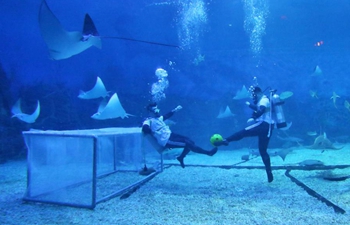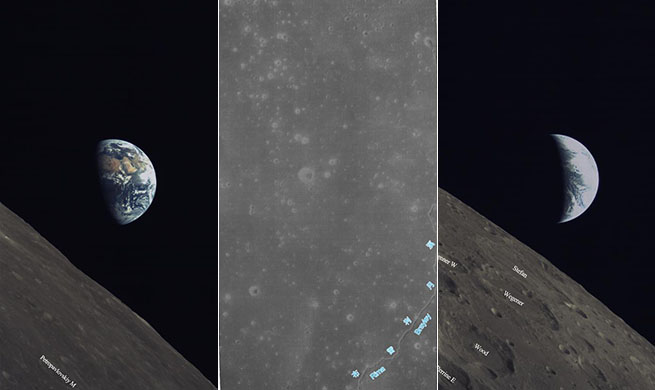BERLIN, June 14 (Xinhua) -- Nearly 95 percent of the earth's seabed has not yet been explored, a circumstance which means that the depths of our oceans are still less well known to scientists than earth's moon. A team of German engineers now wants to help robots conquer deep-sea exploration as well.
Researchers at the Karlsruhe-based Fraunhofer Institute of Optronics, System Technologies and Image Exploitation (IOSB) are currently presenting a peculiar set of underwater drones to visitors at the CeBIT technology trade fair in Hannover. Some observers have likened the machinery on display to a family of ducklings.
The team of responsible engineers, which calls itself the "Arggonauts", has developed a fully-automated system for deep-sea exploration which hinges on the cooperation between an inflatable catamaran, dubbed "water strider" and a handful of smaller "great diver" vessels.
Assuming the role of the responsible guardian, the "water strider" pulls the "great divers" out to sea, where the diving drones are then released to travel thousands of meters below the water surface to map the seabed and produce high quality images of any creatures that they encounter. Once the exploratory tasks are complete, the 2-and-a-half-meter long diving drones resurface and are carefully collected by the mothership and before being dragged back to shore.
The "Arggonauts", which are led by Gunnar Brink of the IOSB, have already won some early praise for their innovation and were recently named among a small group of finalists in the Shell Ocean Discovery XPrize. The international competition is intended to promote better understanding of the earth's deep seas with the winning project receiving 4 million U.S. dollars in prize money.
As exemplified by James Cameron's "Deepsea Challenger" mission, in which the large submarine driven by the Hollywood director to a depth of 10,898 meters cost 10 million U.S. dollars just to build, traditional human deep-sea exploration is anything but cheap. In comparison, the automated family constituted by the "water strider" and its faithful "great divers" offers considerable more bang for buck.
In order to clinch the Ocean Discovery XPrize sponsored by Shell, the "Arggonauts" will have to demonstrate the practical use of their technology by exploring at least 250 square kilometres of unchartered seabed territory at a depth of 4,000 meters within 24 hours. The Karlsruhe-based researchers are confident that, ultra-sound technology, four special cameras and an LED flash system installed on their "great divers" will do the trick.
The IOSB engineers have emphasized, however, that they are not just interested in the prize money offered by Shell but want to advance the progress of automated technology and protect the natural environment as their overriding goals. The ocean seabed is of growing interest to resource-extracting companies as a source of valuable minerals, raising urgent questions over how such commercial activity can be conducted with minimal disruption to marine life.
The German environmental agency (UBA) recently warned that an underwater mining boom poses a serious threat to deep-sea animals and plants. The "Arggonauts" hope that their mapping and imaging solutions can help prevent irreparable damage to one of the least-explored environments on the planet.

















